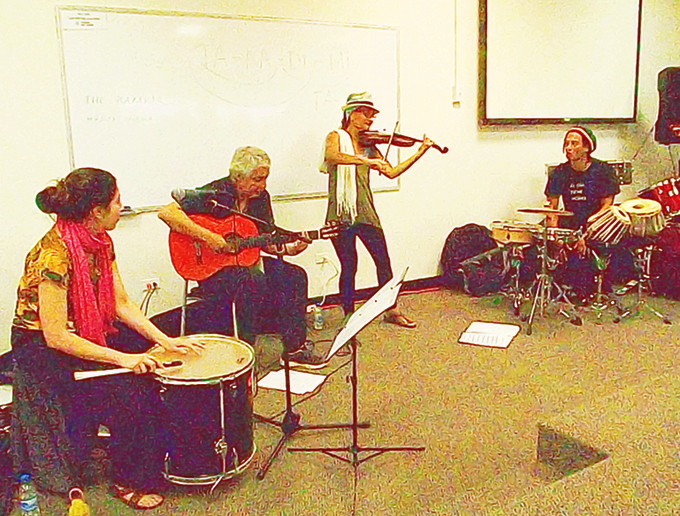
The Black Tea Project’s seminar at the Panama Jazz Festival
by Eric Jackson
Is it crude, boorish and downright incorrect to call ANYTHING coming out of Panama “world music?” What IS that stuff, anyway? Is it music that’s not based on the Western eight-note scale or its accompanying notions about tempo? Is it stuff played on traditional instruments not of European origin? Is it the folk music of folks whose lives are considered unworthy of notice in the hallowed halls of the major US television corporations? Does the guy playing on a synthesizer for Palestinian dabke qualify? What about Cusco, those Germans who played a fusion largely informed by Andean music on electronic instruments? Or is that latter stuff “cross-cultural fusion” when acoustic or “new age” when electronic?
Having noted the semantic issues, for this reporter’s present purpose let’s take “world music” to be those sounds of or informed by cultures alien to those considered relevant by those who compile the playlists of any commercial radio station that you are likely to hear. Like, for example the rhythms that the Black Tea Project’s percussionist Osvaldo Jorge learned while studying in India. Like the sounds that the band’s co-founder Graciela “Chelín” Núñez hears, likes and plays when she’s out of the classical violinist mode at which she has excelled.
Like another noteworthy and eclectic Panamanian band of shifting composition, Rómulo Castro’s Grupo Tuira, the lineup at the Black Tea Project has constants but it’s hardly ever the same from one gig to the next. It’s Graciela and Osvaldo, and whoever else at the moment. For the Black Tea Project’s workshop at the Panama Jazz Festival, it was the usual two plus vocalist Valentina Sousa and guitarist Adrián Alvarado. Sousa is a native of Chitre who moved to Italy as an adolescent and later went to Spain. Alvarado was born in Brazil but has spent years of his life in Germany and Spain.
Jorge plays the tablas and the hang, which would tend to be defined as world music instruments in this hemisphere, as well as other percussion instruments more familiar to Panamanian audiences. On the whiteboard he charted out beats unlike anything that which a Panamanian kid preparing to march in one of the November parades would be taught in school.
Is “música típica” played on an accordion? That is the emblematic instrument of Panamanian cumbia these days, but once the violin was more common in that genre, and violinist Núñez has long been at the interface of classical music and this country’s folk traditions. But with the Black Tea Project she goes farther afield.
How far, at this session Valentina Sousa mentioned a couple of influences, the Kurdish family band The Kamkars and the Moroccan tribal Gnawa music that has over the years diffused into other places and cultures. Speaking mainly with his guitar, Alvarado pointed out Spain’s flamenco tradition in passing. In Spain, political and cultural conservatives tend to be in denial about flamenco’s roots, arguing that the oldest written records available to them go back a little more than 200 years and say that it was from Andalusia and old back then. But of course, 200 years ago Spain was just coming out of the centuries of censorship by the Spanish Inquisition, in which any positive mention of the non-Western Moorish and Roma cultures tended to be suppressed. The better flamenco scholars acknowledge the important Roma (Gypsy) role in that genre’s origins. The Roma people and culture, of course, originated in India.
Before getting into any of that, however, there was a surprise addition to the lesson plan. An electronic part was missing, so this performance, in a room with white noise from an air conditioner, would have to be acoustic despite plans for its electronic amplification. Thus the positions where the musicians played and the directions in which they faced had to be shifted around, and with this a mini-lecture about the differences between acoustic and amplified performances, and an implicit lesson in going on with the show in the face of surprises.
It was, as usual, the good stuff.


~ ~ ~
These announcements are interactive. Click on them for more information.










